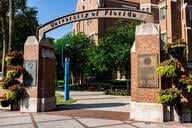You have /5 articles left.
Sign up for a free account or log in.

FG Trade/E+/Getty Images
President Joe Biden’s student loan forgiveness plan—though temporarily blocked by a federal court—is a logical starting place for addressing the nation’s crisis of college affordability. But it is a mere entry point into a more complex conversation about the systemic issues of inequity afflicting higher education today. The unsustainable costs of higher education continue to make the path to college completion lengthy, expensive and risky for many students, especially Black, Latino and other historically marginalized learners who, frankly, have been quite poorly served by higher education in the past.
Many of these students are voting with their feet, as Black, Latino and Native American college enrollment has eroded over the past two years. Absent more broad-based action by educators, colleges and policy makers, these times will come to represent a period of stagnation for equity in higher education.
We can’t let that happen. We cannot allow current or future disruptions to turn back the clock on generations of progress toward realizing the educational aspirations of students of color. Creating pathways to and through college for students from underserved communities will take a renewed commitment and additional funding.
Consider the data: no state has a public higher education system with a student body that reflects its demographic profile. Black and Latino students are woefully underrepresented at public flagship universities. Although community colleges, historically Black universities and minority-serving institutions play a vital role in serving first-generation students and students from low-income backgrounds, these same institutions receive lower levels of public and private funding that could be used to provide the support and resources these students need to thrive.
It should come as no surprise that a widening racial divide manifests itself in college completion statistics. Completion rates among Latino students are 18 percentage points lower than those of white students; for Black students, they’re 25 points lower. Black and Latino students also disproportionately attend college part-time because they have to work to pay tuition and support themselves and their families. Part-time college students take longer to finish and over the course of a lifetime lose earnings. The fact that disparities based on race and ethnicity are still so pervasive remains a national injustice with devastating long-term economic consequences.
To help remedy this, colleges and universities must offer multiple on-ramps for learners to enter school, earn credits in a timely manner and stay on a path to a degree or another credential of value. They should align the college experience to ensure that students can reach their academic and career goals. They must ensure that the campus climate is inclusive and welcoming for students of color. Throughout a student’s college experience, institutions must address student needs—financial, academic and personal—that prevent students from succeeding and graduating. Colleges—especially those that serve large populations of students of color and underresourced students—must invest in evidence-based practices and structural reforms that can close stubborn and systemic institutional performance gaps in higher education.
Initiatives that combine academic planning and advising and basic needs support — such as CUNY ASAP in New York City and Project Quest in San Antonio—are associated with increased course completion, timely acquisition of college credits and increased postgraduation earnings. The ASAP program doubled associate degree graduation rates at the City University of New York and at three Ohio community colleges where it was replicated. In the Midwest, Illinois Central College saw a 33 percent increase in Black student retention rates after implementing a holistic coaching and advising program in partnership with the nonprofit InsideTrack.
Federal policy makers must increase funding not only to help proven programs expand to more campuses and scale but also to make higher education more equitable and meet the needs of today’s students.
Congressional lawmakers should increase funding for the Postsecondary Student Success Grant program to $200 million, an amount included in a bill recently passed by the House Appropriations Committee. Doubling the Pell Grant and creating a state and federal partnership to make college debt-free would remove the affordability barrier that causes so many students to borrow so much money. These investments must be accompanied by an equal and concurrent investment in the supports needed to ensure that every learner regardless of their circumstances can access and ultimately complete college.
To achieve the lasting change and sustainable growth that our country needs, we must first make good on the historic promise of higher education as a lever for social and economic mobility. Millions of Black, Latino and Native American current and future students are depending on us to ensure that the disruption of recent years doesn’t derail their education and career goals.
Making good on the promise of college completion is about more than simply making college more affordable. Ultimately, it requires shattering the other barriers to student success and college completion that have for too long held back students of color.




